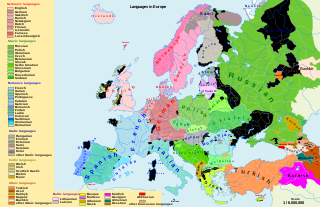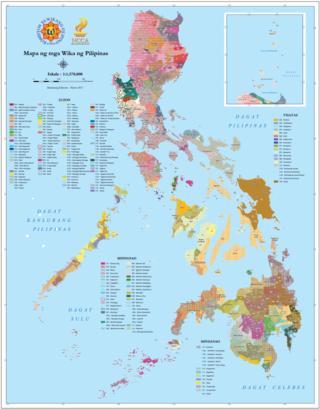
There are over 250 languages indigenous to Europe, and most belong to the Indo-European language family. Out of a total European population of 744 million as of 2018, some 94% are native speakers of an Indo-European language. The three largest phyla of the Indo-European language family in Europe are Romance, Germanic, and Slavic; they have more than 200 million speakers each, and together account for close to 90% of Europeans.

Russian is an East Slavic language, spoken primarily in Russia. It is the native language of the Russians and belongs to the Indo-European language family. It is one of four living East Slavic languages, and is also a part of the larger Balto-Slavic languages. It was the de facto and de jure official language of the former Soviet Union. Russian has remained an official language in independent Russia, Belarus, Kazakhstan, Kyrgyzstan, and Tajikistan, and is still commonly used as a lingua franca in Ukraine, Moldova, the Caucasus, Central Asia, and to a lesser extent in the Baltic states and Israel.

Pakistan is a multilingual country with over 70 languages spoken as first languages. The majority of Pakistan's languages belong to the Indo-Iranian group of the Indo-European language family.

The region known as Hispanic America and historically as Spanish America is all the Spanish-speaking countries of the Americas. In all of these countries, Spanish is the main language - sometimes sharing official status with one or more indigenous languages or English, and Latin Catholicism is the predominant religion.

There are some 130 to 195 languages spoken in the Philippines, depending on the method of classification. Almost all are Malayo-Polynesian languages native to the archipelago. A number of Spanish-influenced creole varieties generally called Chavacano along with some local varieties of Chinese are also spoken in certain communities. The 1987 constitution designates Filipino, a standardized version of Tagalog, as the national language and an official language along with English. Filipino is regulated by Commission on the Filipino Language and serves as a lingua franca used by Filipinos of various ethnolinguistic backgrounds.

The Ivatan language, also known as Chirin nu Ivatan, is an Austronesian language spoken in the Batanes Islands of the Philippines.

In Uganda the most spoken language in the capital city is Luganda, followed by English, as all schools in Uganda use it in their studies due to the introduction of English during the colonial period. English is also the language of business and judicial matters. Most spoken after Luganda and English is Swahili. This language is more common in neighbouring Kenya and Tanzania. Swahili is taught in schools as an optional additional language and it is mostly spoken by the Ugandan army. In 2005, there were talks to include Swahili as the second official language as it was seen as neutral, however this is still not ratified by the government. Swahili is used among some communities bordering South Sudan and Kenya.

Barbacoan is a language family spoken in Colombia and Ecuador.

Chuukic, historically also rendered as Trukic, is a subgroup of the Chuukic–Pohnpeic family of the Austronesian language family. The languages are primarily spoken in Chuuk State and Yap State of the Federated States of Micronesia, as well as in the outer islands of Palau. The Carolinians of the Commonwealth of the Northern Mariana Islands also speak their own language distinct from the historically native Chamorro people.
Kenya is a multilingual country. The two official languages of Kenya, Swahili and English are widely spoken as lingua francas; however, including second-language speakers, Swahili is more widely spoken than English. Swahili is a Bantu language native to East Africa and English is inherited from British colonial rule.

Ekari is a Trans–New Guinea language spoken by about 100,000 people in the Paniai lakes region of the Indonesian province of Central Papua, including the villages of Enarotali, Mapia and Moanemani. This makes it the second-most populous Papuan language in Indonesian New Guinea after Western Dani. Language use is vigorous. Documentation is quite limited.

Spanish is the language that is predominantly understood and spoken as a first or second language by nearly all of the population of Argentina. According to the latest estimations, the population is currently greater than 45 million.

The main languages spoken in Sri Lanka are Sinhala and Tamil. Several languages are spoken in Sri Lanka within the Indo-Aryan, Dravidian, and Austronesian families. Sri Lanka accords official status to Sinhala and Tamil, with English as a recognised language. The languages spoken on the island nation are deeply influenced by the various languages in India, Europe and Southeast Asia. Arab settlers and the colonial powers of Portugal, the Netherlands and Britain have also influenced the development of modern languages in Sri Lanka. See below for the most-spoken languages of Sri Lanka.

Papua New Guinea, a sovereign state in Oceania, is the most linguistically diverse country in the world. According to Ethnologue, there are 840 living languages spoken in the country. In 2006, Papua New Guinea Prime Minister Sir Michael Somare stated that "Papua New Guinea has 832 living languages ."

There are two dozen languages of Bhutan, all members of the Tibeto-Burman language family except for Nepali, which is an Indo-Aryan language, and the Bhutanese Sign Language. Dzongkha, the national language, is the only native language of Bhutan with a literary tradition, though Lepcha and Nepali are literary languages in other countries. Other non-Bhutanese minority languages are also spoken along Bhutan's borders and among the primarily Nepali-speaking Lhotshampa community in South and East Bhutan. Chöke is the language of the traditional literature and learning of the Buddhist monastics.

The Tharu or Tharuhat languages are any of the Indo-Aryan languages spoken by the Tharu people of the Terai region in Nepal, and neighboring regions of Uttarakhand, Uttar Pradesh and Bihar in India.
Satawalese is a Micronesian language of the Federated States of Micronesia. It is nearly mutually intelligible with Mortlockese and Carolinian.
Ujir is a language spoken on the Aru Islands of eastern Indonesia, spoken in the villages of Ujir and Samang in northwestern Aru. As of 2015, it is highly endangered, since it is only spoken by a small fraction of the population of the two villages.

The Ibanag language is an Austronesian language spoken by up to 500,000 speakers, most particularly by the Ibanag people, in the Philippines, in the northeastern provinces of Isabela and Cagayan, especially in Tuguegarao, Solana, Abulug, Camalaniugan, Lal-lo, Cabagan, Tumauini, San Pablo, Sto. Tomas, Sta. Maria, and Ilagan and other neighboring towns and villages around the Cagayan River and with overseas immigrants in countries located in the Middle East, United Kingdom, and the United States. Most of the speakers can also speak Ilocano, the lingua franca of northern Luzon island. The name Ibanag comes from the prefix I which means 'people of', and bannag, meaning 'river'. It is closely related to Gaddang, Itawis, Agta, Atta, Yogad, Isneg, and Malaweg.

Mapia Atoll, historically known as the Freewill Islands or San David, is an atoll in the Pacific Ocean. It is located in Papua province of Indonesia, approximately 190 kilometers north of the city of Manokwari and 630 kilometers from the islands of Palau. It consists of two main islands, Bras (Berasi) and Pegun (Mapia), the smaller Fanildo, and two minor islands, Bras Kecil and Fanildo Kecil. The islands constitute a part of West Supiori District within Supiori Regency, Papua. The population at the 2020 Census was 199.

















